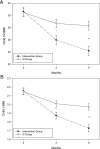Efficacy of family-based weight control program for preschool children in primary care
- PMID: 22987879
- PMCID: PMC4074628
- DOI: 10.1542/peds.2012-0701
Efficacy of family-based weight control program for preschool children in primary care
Abstract
Objective: To test the efficacy of an innovative family-based intervention for overweight preschool-aged children and overweight parents conducted in the primary care setting.
Methods: Children with BMI ≥ 85th percentile and an overweight parent were randomized to intervention or information control (IC). Trained staff delivered dietary and physical/sedentary activities education to parents over 6 months (10 group meetings and 8 calls). Parents in the intervention received also behavioral modification. An intention-to-treat analysis was performed by using mixed analysis of variance models to test changes in child percent over BMI (%OBMI) and z-BMI and to explore potential moderators of group differences in treatment response.
Results: Ninety-six of 105 randomized families started the program: 46 children (31 girls/15 boys) in the intervention and 50 (33 girls/17 boys) in the IC, with 33 and 39 mothers and 13 and 11 fathers in intervention and IC, respectively. Baseline characteristics did not differ between groups. Children in the intervention group had greater %OBMI and z-BMI decreases at 3 and 6 months compared with those assigned to IC (P < .0021). A greater BMI reduction over time was also observed in parents in the intervention compared with parents assigned to IC (P < .0001). Child %OBMI and parent BMI changes were correlated (r = .31; P = .003). Children with greater baseline %OBMI were more likely to have a greater %OBMI decrease over time (P = .02).
Conclusions: Concurrently targeting preschool-aged overweight youth and their overweight parents for behavioral weight control in a primary care setting reduced child %OBMI and parent BMI, with parent and child weight changes correlating.
Trial registration: ClinicalTrials.gov NCT01029834.
Figures
References
-
- Centers for Disease Control and Prevention. NCHS Health E-stats. 2010. Available at: www.cdc.gov/nchs/data/hestat/obesity_child_07_08/htm/. Accessed January 30, 2012
-
- Ogden CL, Carroll MD, Curtin LR, Lamb MM, Flegal KM. Prevalence of high body mass index in US children and adolescents, 2007–2008. JAMA. 2010;303(3):242–249 - PubMed
-
- Whitaker RC, Wright JA, Pepe MS, Seidel KD, Dietz WH. Predicting obesity in young adulthood from childhood and parental obesity. N Engl J Med. 1997;337(13):869–873 - PubMed
-
- Charney E, Goodman HC, McBride M, Lyon B, Pratt R. Childhood antecedents of adult obesity. Do chubby infants become obese adults? N Engl J Med. 1976;295(1):6–9 - PubMed




